
Domino’s Pizza is one of the most popular pizza chains in the world, known for its delicious pies and fast delivery. But what about the boxes that the pizza comes in? Can they be recycled? This is a question that many customers have, and it’s an important one when it comes to reducing our environmental impact.
The good news is that Domino’s pizza boxes can indeed be recycled, but there are a few things you need to know before tossing them in the recycling bin.
Firstly, it’s important to note that the box should be free of any leftover food or grease stains. While a small amount of grease is generally acceptable, heavily soiled boxes can contaminate other recyclables and make them unrecyclable. So, before recycling your pizza box, make sure to remove any leftover pizza, napkins, or other food items.
It’s also worth mentioning that the cardboard used in Domino’s pizza boxes is typically made from recycled materials itself. This means that by recycling your pizza box, you’re not only reducing waste but also supporting the recycling industry and promoting the use of sustainable materials.
Lastly, be sure to check with your local recycling guidelines to ensure that pizza boxes are accepted. While most recycling programs do accept pizza boxes, some may have specific requirements or restrictions, such as removing any additional inserts or handles. It’s always a good idea to familiarize yourself with the recycling rules in your area to ensure that your efforts are effective.
So, the next time you order a delicious pizza from Domino’s, remember that the box it comes in can be recycled. By properly disposing of your pizza box, you’re doing your part in reducing waste and protecting our environment.
- Recycling Domino’s Pizza Boxes: What You Should Consider
- 1. Cleanliness
- 2. Material Composition
- 3. Local Recycling Guidelines
- Choosing the Right Recycling Bin for Pizza Boxes
- Removing Food Residue from Pizza Boxes
- 1. Scrape off any excess food
- 2. Remove oil and grease stains
- Breaking Down the Pizza Box for Recycling
- Materials Needed
- Step-by-Step Process
- Why is it Important to Break Down Pizza Boxes?
- The Impact of Grease and Cheese on Recycling
- The Importance of Clean Pizza Boxes for Recycling
- Best Practices for Cleaning Pizza Boxes
- Conclusion
- Grease-Soaked Boxes: Alternative Options for Disposal
- Conclusion
- Q&A:
- Can Domino’s pizza boxes be recycled?
- What should I do before recycling a Domino’s pizza box?
- Can I recycle a Domino’s pizza box with grease stains?
- Where can I recycle my Domino’s pizza box?
- What should I do if my local recycling program does not accept pizza boxes?
Recycling Domino’s Pizza Boxes: What You Should Consider
Recycling is an important step in reducing our environmental impact and promoting sustainability. However, when it comes to recycling pizza boxes, like those from Domino’s, there are a few factors to consider.
1. Cleanliness
Before recycling your pizza box, make sure it is clean and free from any food residues. Grease and cheese can contaminate other recyclables and disrupt the recycling process. If the box is too dirty, it’s best to dispose of it in the regular trash.
2. Material Composition
Most Domino’s pizza boxes are made from corrugated cardboard, which is recyclable. However, some boxes may contain non-paper elements like plastic window sheets or additional packaging materials. These non-paper elements should be removed and disposed of separately before recycling the box.
3. Local Recycling Guidelines
Recycling guidelines can vary by location, so it’s essential to check with your local recycling facility or municipality to ensure that they accept pizza boxes for recycling. Some recycling centers have specific guidelines, such as requesting the removal of any grease-soaked portions or only accepting boxes without any non-paper elements.
By following these considerations, you can contribute to the proper recycling of Domino’s pizza boxes and help reduce waste and promote a more sustainable future.
Choosing the Right Recycling Bin for Pizza Boxes
When it comes to recycling pizza boxes, it’s important to choose the right recycling bin to ensure that your efforts are effective. Here are a few key points to keep in mind when selecting a recycling bin for pizza boxes:
1. Size: Make sure the recycling bin you choose is large enough to accommodate pizza boxes without folding or crumpling them. Pizza boxes can be quite large, so opt for a bin that is spacious and deep enough to hold them.
2. Material: Look for a recycling bin that is made from durable and recyclable materials, such as plastic or metal. These bins are more likely to withstand the weight and shape of pizza boxes and can be easily recycled themselves.
3. Lid: Consider choosing a recycling bin with a lid to keep the pizza boxes contained and prevent them from blowing away or creating a mess. This is especially important if you live in an area with strong winds or frequent storms.
4. Labeling: Look for a recycling bin that is clearly labeled for paper or cardboard recycling. This will help ensure that your pizza boxes end up in the right place and can be properly processed for recycling.
5. Accessibility: Choose a recycling bin that is easily accessible for both you and your waste management service. Make sure it is located in a convenient spot where you can easily place your pizza boxes without any hassle.
By choosing the right recycling bin for pizza boxes, you can contribute to the overall success of recycling efforts and help reduce waste in our environment. Make sure to follow your local recycling guidelines and regulations to ensure proper recycling practices.
Removing Food Residue from Pizza Boxes
When it comes to recycling pizza boxes, one of the most important steps is to remove any food residue from the box. Food residue can contaminate the recycling process and make it more difficult for the materials to be properly recycled.
Here are some steps you can take to remove food residue from pizza boxes:
1. Scrape off any excess food
Before recycling your pizza box, it’s important to remove any large pieces of food or toppings. Use a spatula or a paper towel to gently scrape off any excess food from the box. Make sure to discard the removed food in the appropriate waste bin.
2. Remove oil and grease stains
Pizza boxes are often stained with oil and grease, which can be difficult to remove. To tackle oil and grease stains, you can use a small amount of dishwashing liquid or detergent. Apply the soap to a sponge or a soft cloth and gently scrub the stained areas of the box. Rinse the box thoroughly to remove any soap residue.
If the stains are particularly stubborn, you can try using a mixture of baking soda and water. Apply the paste to the stained areas and let it sit for a few minutes before scrubbing it off. Rinse the box well after cleaning.
It’s important to note that not all boxes can be cleaned effectively. If the box is heavily soaked with oil or has significant amounts of food residue, it may be best to discard it in the regular trash instead of trying to recycle it.
By following these steps and ensuring that your pizza boxes are clean and free of food residue, you can help contribute to a more efficient and effective recycling process.
| Benefits of removing food residue from pizza boxes |
|---|
| Prevents contamination of recycling materials |
| Improves the quality of recycled materials |
| Reduces the amount of waste in landfills |
Breaking Down the Pizza Box for Recycling

When it comes to recycling pizza boxes, the first step is to break them down. This not only makes them easier to transport and store, but it also ensures that they are recycled properly.
Materials Needed
Before you start breaking down your pizza box, make sure you have the following materials:
- Scissors or a box cutter
- Tape or adhesive
- Clear plastic bags
Step-by-Step Process
Follow these steps to break down your pizza box for recycling:
- Start by removing any leftover food or grease stains from the box. You can use a napkin or paper towel to absorb excess grease.
- Use scissors or a box cutter to remove any non-recyclable parts of the box, such as the metal pizza saver or any plastic inserts.
- Next, fold the box in half to separate the lid from the base. If there is a perforated line, use it as a guide for folding.
- Once the box is folded in half, you can now fold it in half again vertically. This will help you break down the box further.
- Continue folding the box until it is small enough to fit into your recycling bin or bag.
- If necessary, use tape or adhesive to secure any loose flaps or edges.
- Finally, place the broken-down pizza box in a clear plastic bag before putting it in your recycling bin. This helps to prevent any loose pieces from getting lost in the recycling process.
Why is it Important to Break Down Pizza Boxes?
Breaking down pizza boxes is important for several reasons:
- It allows for efficient transportation and storage of the boxes.
- It ensures that the boxes can be properly recycled, as intact boxes may be rejected by recycling facilities.
- It prevents contamination of other recyclable materials, such as paper or cardboard, by food residue or grease stains.
| Accepted Materials | Not Accepted Materials |
|---|---|
| Clean pizza boxes | Pizza savers |
| Clean paper | Plastic inserts |
| Cardboard | Food residue or grease stains |
By following these steps and guidelines, you can ensure that your pizza boxes are properly recycled and contribute to a more sustainable environment.
The Impact of Grease and Cheese on Recycling
When it comes to recycling pizza boxes, one of the main challenges is the presence of grease and cheese. While cardboard pizza boxes are typically recyclable, the presence of these food residues can create problems in the recycling process.
The grease and cheese can contaminate the recycling process and reduce the quality of the recycled materials. When these materials mix with cardboard, they can cause discoloration, weakening, and ultimately make the paper fibers unsuitable for recycling.
As a result, it is important to ensure that pizza boxes are clean and free of any food residues before placing them in the recycling bin. You can scrape off any leftover cheese or toppings and discard them in the regular trash. If the box is only greasy, you can tear off the clean top half and recycle that portion, while disposing of the greasy bottom half in the trash.
Moreover, it is crucial to remember that the presence of grease and cheese can contaminate other recyclable materials as well. For instance, if a greasy pizza box is placed in a bin with other clean paper or cardboard, the contamination can cause the entire batch to be rejected for recycling.
So, while pizza boxes can be recycled, it is important to be mindful of the impact that grease and cheese can have on the recycling process. By removing any food residues and separating the clean portions from the greasy ones, we can help ensure that these boxes can be effectively recycled and contribute to a more sustainable environment.
The Importance of Clean Pizza Boxes for Recycling
When it comes to recycling pizza boxes, cleanliness is key. Clean pizza boxes are essential to ensure that the recycling process is efficient and effective.
One of the main reasons why clean pizza boxes are important for recycling is because of contamination. Pizza boxes that are stained with grease or have leftover food particles can contaminate other recyclable materials and make them unsuitable for recycling. This is because grease and food particles can mix with paper fibers during the recycling process, rendering them useless.
Moreover, dirty pizza boxes can attract insects and pests, which can further hinder the recycling process. Not only can pests cause damage to recycling facilities, but they can also spread diseases and pose health risks to workers. By ensuring that pizza boxes are clean before recycling, we can help maintain the cleanliness and functionality of recycling facilities.
Best Practices for Cleaning Pizza Boxes
To ensure that pizza boxes are clean and ready for recycling, follow these best practices:
- Remove any leftover pizza and food scraps from the box. Dispose of them separately in a compost bin or trash.
- Use a clean cloth or paper towel to wipe away any grease or oil stains from the box.
- Check for any remaining cheese or toppings and remove them from the box.
- If the box is heavily soiled or greasy, tear off the clean top portion and recycle the clean section.
- Flatten the clean pizza box to save space and make it easier to transport to the recycling facility.
Conclusion

In conclusion, clean pizza boxes play a crucial role in the recycling process. By ensuring that pizza boxes are free from grease, oil, and food particles, we can help prevent contamination and maintain the functionality of recycling facilities. By following simple cleaning practices, we can all contribute to a more sustainable and efficient recycling system.
Grease-Soaked Boxes: Alternative Options for Disposal
When it comes to recycling pizza boxes, one issue that often arises is the grease-soaked boxes. The grease and oil from pizza can contaminate the recycling process and make it difficult to recycle the cardboard. However, this doesn’t mean that grease-soaked pizza boxes have to go straight to the landfill. There are alternative options for disposal that can help reduce waste and environmental impact.
Composting: One alternative option is to compost the grease-soaked boxes. Cardboard is a great material for composting, as it breaks down easily and adds carbon to the compost pile. To compost pizza boxes, simply tear them into smaller pieces, making sure to remove any excess cheese or toppings. The grease-soaked cardboard can then be added to the compost pile along with other organic matter, such as food scraps and yard waste.
Incineration: Another option for disposing of grease-soaked pizza boxes is incineration. While burning cardboard is not an ideal solution, it can be a better alternative to sending it to the landfill. Many waste-to-energy facilities use advanced technologies to convert cardboard into energy through controlled incineration processes. This helps reduce reliance on fossil fuels and minimizes the environmental impact.
Reuse: If composting or incineration is not an option, consider reusing the grease-soaked pizza boxes in creative ways. For example, you can use them as disposable plates for outdoor events or picnics. They can also be cut into smaller pieces and used as disposable mats for arts and crafts activities. By finding alternative uses for these boxes, you can extend their lifespan and reduce waste.
Conclusion
Giving grease-soaked pizza boxes a second life can help minimize waste and reduce landfill usage. Composting, incineration, and reusing are all viable options for disposing of these boxes in an environmentally friendly way. It’s important to remember that even small actions like these can have a positive impact on the environment and contribute to a more sustainable future.
Q&A:
Can Domino’s pizza boxes be recycled?
Yes, Domino’s pizza boxes can be recycled. However, there are a few things you need to know before recycling them.
What should I do before recycling a Domino’s pizza box?
Before recycling a Domino’s pizza box, you should make sure it is clean and free from any food residue. If there are grease stains or leftover food, it is better to throw it in the regular trash.
Can I recycle a Domino’s pizza box with grease stains?
No, it is not recommended to recycle a Domino’s pizza box with grease stains. The grease can contaminate other materials in the recycling process.
Where can I recycle my Domino’s pizza box?
You can recycle your Domino’s pizza box in your local recycling program. Most municipalities accept pizza boxes for recycling, but it is always a good idea to check the guidelines of your specific recycling program.
What should I do if my local recycling program does not accept pizza boxes?
If your local recycling program does not accept pizza boxes, you can try to compost it if you have a composting system. Otherwise, the pizza box should be thrown in the regular trash.